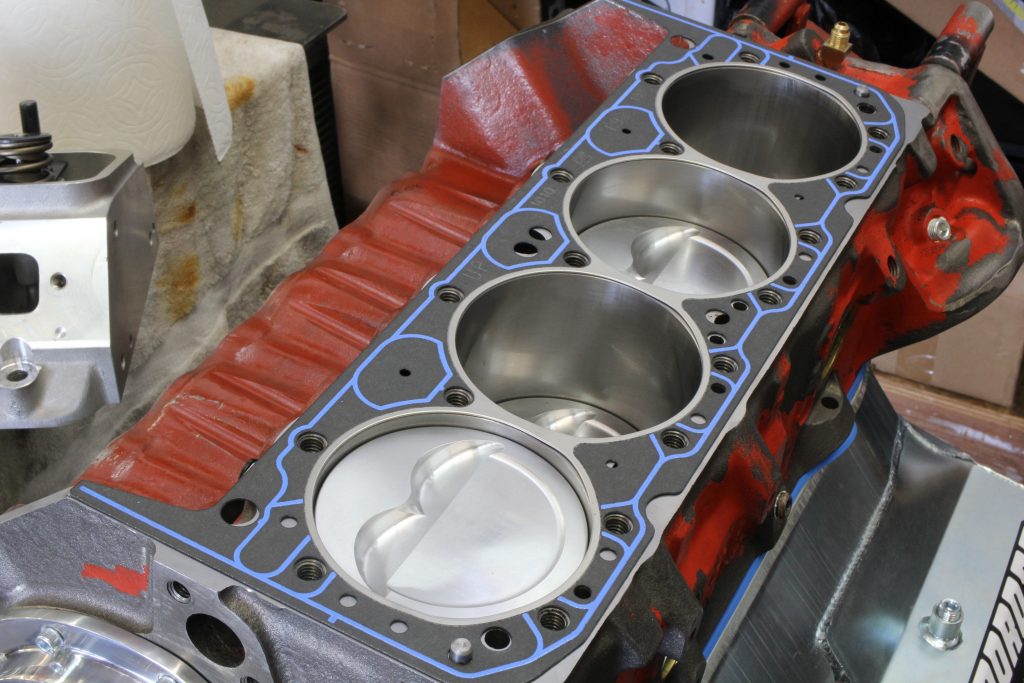
I’ve got a 400 cubic small block Chevy that I had the machine shop bore to 4.155. I’m collecting parts to put it back together and used some of my old parts for the part numbers. We tossed the head gasket on the block and discovered the inner part of the head gasket is inside the bore. In other words, part of the head gasket actually overlaps inside the bore. I didn’t build this engine and while I’ve not done a lot of engine work, I’m pretty sure that’s not right. I’d like to get your opinion.
J.P.
Jeff Smith: The short answer is you are correct. The small block Chevy has been produced with a raft of different bore diameters ranging from an absolutely tiny 3.50 inches for the little-known 267 V8 to the 400’s 4.125 inch diameter. As a result, there are a dozens of head gaskets in various thicknesses and bore sizes for these engines. It sounds like the previous builder wasn’t paying attention and probably dropped a set of 350 Chevy heads gaskets that offer roughly a 4.090 to perhaps a 4.100 inch gasket bore diameter.
If you are not paying attention, it would be very easy to slap a 350 head gasket on the engine and not look to see whether the gasket intrudes into your 400’s much larger 4.155 inch bores. A gasket with a 4.100 inch bore would overhang the cylinder bore by 0.0275 inch all the way around. That’s bad.
This situation could quickly create a hot spot in the chamber area that would cause detonation and possibly even pre-ignition. As a quick explanation, detonation is defined as an uncontrolled combustion that occurs after the spark plug has fired. This uncontrolled combustion creates a pressure spike that can damage pistons, flatten connecting rod bearings, and generally cause internal mayhem.
Pre-ignition is even worse. As the name implies, that hot spot in the chamber from the gasket could become hot enough to light off the air and fuel long before the spark plug is scheduled to fire. When pre-ignition happens, the cylinder pressure quickly builds while the piston is moving upward. As you can imagine, catastrophic things happen. We experienced pre-ignition an engine running on E85 once that occurred without warning. The culprit was a spark plug with too high a heat range, but the damage included a broken piston. We were lucky–it could have been far worse.
So the answer is to use a head gasket intended for a 4.125-inch or larger bore size. For a 4.155-inch bore 400, a Fel-Pro performance gasket like the FEL-1045 offers a gasket bore inside diameter of 4.180-inch, which places it close to but still outside the cylinder bore. They also offer a 4.200 inch gasket (FEL-1044), but the 4.180 inch gasket appears to be the better choice.
So the message should be clear. Pay attention to the small details when building an engine and make sure the head gasket does not overhang into the cylinder bore. You will save yourself a lot of grief!

My 355 SBC had the pistons down in the bores 26-28 thou. I used a 1094 fel pro set. 4.100″ bore and only 15 thou thick. had flat tops and wanted to set my quench at 40 – 43 thou with 64cc chambers. Came out to 10.38 : 1 static. With my cam it runs fine on 93 pump gas. Timing is conservative at 32-34 degrees. brodix IK 180 heads.
you dont want a gasket to over-hang the tope of the cylinders or be so large that there is a huge pocket space between the block and heads for mixture or exhaust to get trapped in.
Don’t forget that 400 sbc head gaskets also need to have the “steam holes” at each corner.
That’s one of the reasons I dislike S.B.Chevy,too many options{BS} But at least your using Fel-Pro,I feel they are the BEST! They also have a great hot line for any problems you might encounter,very knowledgeable. Head Gaskets are nothing to play with unless you enjoy AGGRAVATION!
Always check the head gasket fit to cylinder head also.I had a problem with overhang on blueprint compression chambers.Caught early and no severe damage from coolant seeping into cylinders ect.Runs Great now with larger bore head gaskets.
I’m building a 496cid out of a 454cid which is bored .060, the bore will now be 4.310. I can’t find a gasket set for the heads to match the bore all I can find is fel-pro #2805 with head gasket of 4.150 or less. Can you help me with the right gasket set? Thanks Fred
summit racing offers a 4.370 head gasket
Would you please give me part number for a sbc .030 over with aluminum heads , is a felpro 1010 a good number ? Thanks.
Have not yet got a reply.
Exactly what I used and yes they are fine just be sure to check valve to piston clearance
I can’t find any 3.5” bore head gaskets for my 267 sbc. I called Cometic and they have never heard of this small bore Chevy. A 305 gasket comes close, but still not right. I lose a lot of compression with a larger bore gasket. Any ideas where I can find a set? Thanks
[…] is up to date on Amazon or at your local LHBS. If your dent is too large for repairs, try to get an oversized gasket; the leak will not go away simply because it is too […]
Buy Hussey Performance gaskets. They are made to order to exact specs, bore size and thickness.